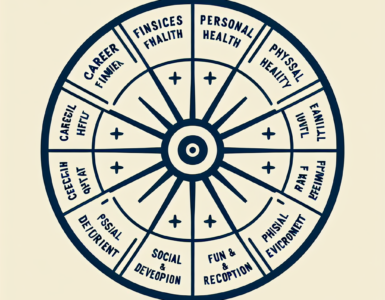Introduction to the Pomodoro Technique
The Pomodoro Technique is a time management method that has gained popularity among young professionals and students looking to enhance their productivity and focus. It is praised for its simplicity and effectiveness in breaking down work into manageable intervals, promoting sustained concentration and preventing burnout.
Origins of the Pomodoro Technique
The Pomodoro Technique was developed in the late 1980s by Francesco Cirillo, an entrepreneur and author. The name “Pomodoro” is derived from the Italian word for “tomato,” inspired by the tomato-shaped kitchen timer Cirillo used during his university days to track his work sessions. The technique has since evolved into a globally recognized productivity tool, embraced by individuals seeking to master their time and workload.
Basic Principles of the Pomodoro Technique
The core concept of the Pomodoro Technique revolves around using a timer to break work into intervals, traditionally 25 minutes in length, known as “Pomodoros.” After each Pomodoro, a short break is taken, providing a moment of rest and recovery before the next interval of focused work begins. The cyclical structure of work and rest is designed to maximize attention and reduce mental fatigue.
| Element | Duration | Purpose |
|---|---|---|
| Pomodoro | 25 minutes | Focused work session |
| Short Break | 5 minutes | Rest and recharge |
| Long Break | 15-30 minutes | Extended rest after multiple Pomodoros |
To fully benefit from the Pomodoro Technique, one must understand and adhere to these foundational principles:
- Work with Time, Not Against It: Using a timer instills a sense of urgency and helps individuals work within the bounds of the set intervals.
- Eliminate Burnout: Regular breaks prevent overexertion and maintain high productivity levels throughout the day.
- Manage Distractions: Intentional focus during Pomodoros encourages a disciplined approach to handling potential interruptions.
- Create a Rhythm: Consistent use of the technique helps establish a productive rhythm, balancing effort with necessary breaks.
In essence, the Pomodoro Technique timer is not just a tool for tracking time—it’s an approach to structuring work that fosters a healthier, more balanced way to achieve one’s goals.
The Pomodoro Technique Explained
The Pomodoro Technique is a time management method that can be used to break down work into intervals, traditionally 25 minutes in length, separated by short breaks. These intervals are referred to as “pomodoros”, after the Italian word for ‘tomato’, inspired by the tomato-shaped kitchen timer that Francesco Cirillo used as a university student when developing this technique.
The Traditional Pomodoro Session Structure
The classic structure of a Pomodoro session consists of four basic steps:
- Choose a Task: Identify the task that needs to be accomplished.
- Set the Timer: Commit to working on the task for the duration of 25 minutes.
- Work on the Task: Work on the task until the timer rings; then put a checkmark on a piece of paper to indicate that one Pomodoro has been completed.
- Take a Short Break: After the timer goes off, take a short break (typically 5 minutes) to rejuvenate before starting the next Pomodoro.
After four Pomodoros have been completed, a longer break is taken (usually 15-30 minutes), which completes one “set”. The cycle is then repeated as necessary.
| Step | Duration | Activity |
|---|---|---|
| Work Interval (Pomodoro) | 25 minutes | Focused work |
| Short Break | 5 minutes | Rest and refresh |
| Long Break (After 4 Pomodoros) | 15-30 minutes | Extended rest |
Tasks and the Pomodoro Technique
When applying the Pomodoro Technique to tasks, it’s important to prioritize and break down larger tasks into manageable “pomodoro-sized” activities. A task that is expected to take several hours should be divided into multiple Pomodoros, with each segment having a clear goal or endpoint. This makes even the most daunting projects approachable and keeps motivation high as progress is visibly marked after each interval.
The technique encourages users to work with time, not against it, and to use the timer as a tool to enhance focus and productivity. It also emphasizes the importance of recording distractions as they occur and deferring them to a later time, ensuring that the current Pomodoro remains as uninterrupted as possible.
By utilizing the pomodoro technique timer, individuals can transform their approach to tasks, creating a more structured and disciplined workflow. This method not only helps in getting tasks completed but also in understanding how much time is actually spent on each activity, leading to better time estimations and planning in the future.
Benefits of Using a Pomodoro Technique Timer
The Pomodoro Technique Timer is a straightforward yet effective tool that has transformed the way individuals approach their work and manage their time. By breaking down work into intervals, typically 25 minutes in length, followed by short breaks, this technique offers several benefits that can enhance productivity and well-being.
Enhanced Focus and Concentration
Utilizing a Pomodoro Technique Timer encourages individuals to work with the time they have, rather than against it. The technique fosters an environment where one is focused on a single task for a set duration without distractions.
| Duration (Minutes) | Activity |
|---|---|
| 25 | Focused Work Session |
| 5 | Short Break |
| 25 | Focused Work Session |
| 15-30 | Long Break (after 4 Pomodoros) |
This structure helps in cultivating a high level of concentration, as one knows they only need to maintain focus for a short, manageable period. The promise of an impending break keeps motivation high and distractions at bay, leading to a more engaged work session.
Improved Time Management Skills
The Pomodoro Technique Timer serves as a physical reminder of the passing of time. By working in 25-minute blocks, individuals become more aware of how they allocate their time to various tasks.
| Task | Pomodoros Required |
|---|---|
| Project Research | 4 Pomodoros |
| Writing Report | 6 Pomodoros |
| Email Correspondence | 2 Pomodoros |
This awareness allows for better planning and prioritizing of tasks, ensuring that time is used efficiently. The technique aids in breaking down larger tasks into smaller, more manageable segments, making it easier to estimate the effort and time required for completion.
Reduced Burnout and Increased Productivity
The regular breaks mandated by the Pomodoro Technique Timer are crucial in preventing burnout. These breaks serve as a reset for the mind, reducing mental fatigue and maintaining a consistent level of productivity throughout the day.
| Work Blocks | Breaks |
|---|---|
| 4 Pomodoros | 1 Long Break |
| 8 Pomodoros | 2 Long Breaks |
| 12 Pomodoros | 3 Long Breaks |
By segmenting the workday into these intervals, individuals are less likely to experience the exhaustion that comes from prolonged periods of work without rest. As a result, they can sustain a higher level of productivity over the course of a workday or study session.
In summary, the Pomodoro Technique Timer helps individuals maximize their focus, refine their time management skills, and maintain a healthy balance between work intensity and rest, leading to enhanced productivity and a reduced likelihood of burnout.
Implementing the Pomodoro Technique Timer in Your Routine
Incorporating the Pomodoro Technique into one’s daily schedule can revolutionize the way tasks are approached, boosting productivity and focus. This section guides individuals through the process of setting up their environment, dividing tasks into Pomodoros, and managing disruptions effectively.
Setting Up Your Environment
Before starting the Pomodoro Technique, it’s crucial to create an environment conducive to focus. This includes:
- Choosing a quiet and comfortable workspace: Minimizing noise and distractions is key.
- Gathering necessary supplies: Ensure all materials required for the tasks are within reach to avoid mid-Pomodoro disruptions.
- Setting up the pomodoro technique timer: Have a timer ready. This can be a physical timer or a digital one.
| Item | Description |
|---|---|
| Workspace | Quiet and distraction-free |
| Supplies | All necessary materials at hand |
| Timer | Ready to use |
Breaking Down Tasks into Pomodoros
Tasks should be broken down into manageable intervals that align with the Pomodoro Technique’s structure:
- Identify tasks for the day: Write a list of tasks to be accomplished.
- Estimate the number of Pomodoros: Assign a realistic number of 25-minute blocks to each task.
- Prioritize tasks: Arrange tasks in order of importance or deadline.
| Task | Estimated Pomodoros |
|---|---|
| Task 1 | 2 Pomodoros |
| Task 2 | 1 Pomodoro |
| Task 3 | 3 Pomodoros |
Dealing with Interruptions
Interruptions are inevitable, but they can be managed without derailing the focus:
- Inform others of the Pomodoro schedule: Let colleagues, friends, or family know about the work intervals to minimize interruptions.
- Use the ‘inform, negotiate, and call back’ strategy: If interrupted, inform the person that you are in the middle of a Pomodoro, negotiate a time to address the issue, and call back when the Pomodoro is complete.
- Keep a notepad handy: Jot down any intrusive thoughts or sudden tasks during a Pomodoro and address them in the break or scheduled time.
Implementing the Pomodoro Technique timer into one’s routine requires initial effort, but with practice, it becomes second nature. By setting up a conducive environment, breaking down tasks into focused intervals, and managing distractions, individuals can enjoy the full benefits of this time management system.
Tips for Pomodoro Technique Success
Maximizing the effectiveness of the Pomodoro Technique requires personalization, monitoring progress, and finding the right balance between work and breaks. Here, we offer some strategies for individuals looking to refine their use of the Pomodoro Technique to better fit their personal and professional lives.
Customizing the Technique for Your Needs
The standard Pomodoro session is 25 minutes of work followed by a 5-minute break. However, not everyone operates at their best within these constraints. Customization is key to ensuring the technique works for you. Some may find a longer work period is more productive, while others may benefit from shorter bursts of focus.
| Work Duration | Short Break | Long Break After Set of |
|---|---|---|
| 25 minutes (Traditional) | 5 minutes | 4 pomodoros |
| 50 minutes | 10 minutes | 2 pomodoros |
| 90 minutes | 15 minutes | 2 pomodoros |
Experiment with the duration of both the work sessions and breaks to find the most effective pattern for your workflow. Keep in mind the importance of taking longer breaks after completing a set of work sessions to prevent fatigue.
Tracking Your Progress
To truly understand how well the Pomodoro Technique is enhancing your productivity, it’s crucial to track your progress. This can be done by recording the number of Pomodoros completed each day and the tasks accomplished in each session.
| Day | Pomodoros Completed | Tasks Completed |
|---|---|---|
| Monday | 8 | 5 |
| Tuesday | 7 | 3 |
| Wednesday | 10 | 6 |
By maintaining a log of your daily Pomodoro sessions and accomplishments, you can identify patterns in your productivity and make informed adjustments to your technique.
Balancing Work and Breaks Efficiently
An essential component of the Pomodoro Technique is finding the optimal balance between work and rest. This balance is critical to maintaining high levels of focus and preventing burnout. The standard recommendation is to take longer breaks—typically around 15 to 30 minutes—after every four Pomodoros to allow for adequate mental recovery.
| Number of Pomodoros | Short Breaks | Long Break |
|---|---|---|
| 4 | 5 minutes each | 15-30 minutes |
Adjust the frequency and duration of breaks as needed to match your personal rhythm. The key is to ensure that breaks are truly restorative, allowing you to return to your tasks with renewed focus and energy.
By customizing the Pomodoro Technique to fit individual needs, diligently tracking progress, and maintaining a healthy balance between work and breaks, users can optimize their productivity and time management skills. Embracing this approach can lead to a more structured and efficient work routine, ultimately contributing to greater success in both professional and personal endeavors.
Beyond the Timer: Building a Pomodoro Habit
Consistency and Routine
The key to reaping the benefits of the Pomodoro Technique is to develop consistency and establish it as a routine. Regular use of the technique fosters discipline and helps to internalize time management as a habitual practice. It is recommended to incorporate the Pomodoro Technique into daily tasks and maintain a consistent schedule to train the brain for focused work sessions.
| Activity | Frequency | Pomodoros per Day |
|---|---|---|
| Work Tasks | Daily | 8-10 |
| Study Sessions | As needed | 6-8 |
| Personal Projects | 3-4 times a week | 4-5 |
By adhering to a structured approach, individuals can improve their ability to manage time and increase their productivity. It’s crucial to start with a clear plan for the day and designate specific times for Pomodoro sessions. This creates a predictable pattern that can enhance focus and efficiency.
Adapting the Technique for Team Collaboration
The Pomodoro Technique can also be adapted for team collaboration. This involves synchronizing Pomodoro sessions among team members to enhance collective productivity and ensure that everyone is working with a unified approach to time management.
| Team Activity | Duration | Breaks |
|---|---|---|
| Collaborative Work | 25 minutes | 5 minutes |
| Team Meetings | 25 minutes | 5 minutes |
| Project Planning | 25 minutes | 15 minutes |
For optimal results, teams should establish ground rules for Pomodoro sessions to minimize interruptions. They can also use this technique to conduct efficient meetings by allotting Pomodoros for discussion and decision-making. This not only maximizes time but also encourages contributions from all team members within the allocated intervals.
Long-Term Impact on Professional and Personal Life
Implementing the Pomodoro Technique timer over the long term can have a profound impact on both professional and personal life. It helps individuals develop a proactive attitude towards time management, leading to a more balanced and fulfilling lifestyle.
| Aspect | Impact |
|---|---|
| Work-Life Balance | Improved |
| Stress Levels | Reduced |
| Productivity | Increased |
The technique’s emphasis on regular breaks can reduce stress and prevent burnout, thereby enhancing overall well-being. As individuals become more adept at managing their time, they often experience a boost in productivity, allowing for more leisure time and a better work-life balance. Over time, the Pomodoro Technique can transform the way one approaches tasks and goals, leading to sustained personal and professional growth.











